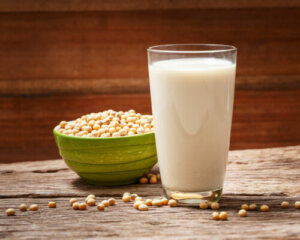Soy Milk for Children: Everything You Need to Know


Written and verified by the nutritionist Saúl Sánchez Arias
Soy milk is a food that usually works as a milk substitute. Many people who are lactose intolerant or allergic to milk proteins include it in their diet for its nutritional value. However, it’s not the best choice for healthy children.
The first thing to note is that there are different qualities of soy milk. Some of those found in supermarkets have large amounts of added sugar, so they’re not considered healthy products.
Cow’s milk: A very complete food
Let’s start by talking about the food that soy beverage replaces: Cow’s milk. This substance has a high concentration of proteins of high biological value, essential to ensuring the growth of children. These nutrients have all the essential amino acids and a good level of digestibility.

According to a study published in the Annals of Nutrition & Metabolism, children should ensure a protein intake of at least 1.5 grams of the nutrient per kilogram of body weight per day to promote development.
It should also be noted that cow’s milk contains micronutrients that are essential for health, such as vitamin D and calcium. Its consumption is considered important to prevent the appearance of bone diseases in the medium term.
However, some experts state that it’s common to suffer from lactose intolerance or malabsorption. For this reason, they sometimes advise against the consumption of the beverage. However, there’s a lot of overdiagnosis in this regard, so many people who could include it in their diet without any problems are deprived of this food.
Soy milk: A less protein-rich food
Unlike cow’s milk, soy milk has a much lower protein content. In addition, the nutrients in this food are of low biological value. This means that they don’t have all the essential amino acids, so supplementation with other products to achieve a complete protein is necessary.
At the same time, the overall nutritional concentration is low in soy milk. It’s true that it may contain certain vitamins, such as those of the B group, and other micronutrients such as calcium, but both their quantity and digestibility values are low.
However, soybeans contain substances called isoflavones, which have been shown to be positive for health, especially in the case of women, according to research published in the journal Cancer, as they can help prevent breast tumors. However, these are very rare in children, so it’s not a reason to promote their consumption.
The importance of choosing a good soy milk
As you’ve seen, from a nutritional point of view, soy milk doesn’t outperform cow’s milk. However, there are children who can’t consume the latter due to intolerance or allergy issues.
In these cases, this plant-based drink can be introduced as a substitute, but it’s important to read the labeling first. It’s common for soy milk to contain large amounts of added sugars or artificial sweeteners to improve its organoleptic characteristics. However, it’s not healthy, so it’s best to discard this type of product.

When choosing soy milk to be consumed by children, it’s best to purchase an organic product without added sugars. The taste will be less pleasant, but its nutritional quality is assured. In any case, using soy milk to replace the consumption of water isn’t recommended.
Soy milk in children is a situational product
Nutrition experts don’t recommend using this vegetable-based drink to replace cow’s milk in children, at least if there’s no disease that determines the absorption of the latter. The nutritional density is lower and small children need a high nutrient intake to ensure their proper growth and development.
In addition, dairy products are associated with better bone health. This is due to the presence of calcium and vitamin D (the latter nutrient isn’t present in soy milk). At the same time, it’s important to note that the vegetable drink contains isoflavones, elements that improve women’s health in the medium term.
Soy milk is a food that usually works as a milk substitute. Many people who are lactose intolerant or allergic to milk proteins include it in their diet for its nutritional value. However, it’s not the best choice for healthy children.
The first thing to note is that there are different qualities of soy milk. Some of those found in supermarkets have large amounts of added sugar, so they’re not considered healthy products.
Cow’s milk: A very complete food
Let’s start by talking about the food that soy beverage replaces: Cow’s milk. This substance has a high concentration of proteins of high biological value, essential to ensuring the growth of children. These nutrients have all the essential amino acids and a good level of digestibility.

According to a study published in the Annals of Nutrition & Metabolism, children should ensure a protein intake of at least 1.5 grams of the nutrient per kilogram of body weight per day to promote development.
It should also be noted that cow’s milk contains micronutrients that are essential for health, such as vitamin D and calcium. Its consumption is considered important to prevent the appearance of bone diseases in the medium term.
However, some experts state that it’s common to suffer from lactose intolerance or malabsorption. For this reason, they sometimes advise against the consumption of the beverage. However, there’s a lot of overdiagnosis in this regard, so many people who could include it in their diet without any problems are deprived of this food.
Soy milk: A less protein-rich food
Unlike cow’s milk, soy milk has a much lower protein content. In addition, the nutrients in this food are of low biological value. This means that they don’t have all the essential amino acids, so supplementation with other products to achieve a complete protein is necessary.
At the same time, the overall nutritional concentration is low in soy milk. It’s true that it may contain certain vitamins, such as those of the B group, and other micronutrients such as calcium, but both their quantity and digestibility values are low.
However, soybeans contain substances called isoflavones, which have been shown to be positive for health, especially in the case of women, according to research published in the journal Cancer, as they can help prevent breast tumors. However, these are very rare in children, so it’s not a reason to promote their consumption.
The importance of choosing a good soy milk
As you’ve seen, from a nutritional point of view, soy milk doesn’t outperform cow’s milk. However, there are children who can’t consume the latter due to intolerance or allergy issues.
In these cases, this plant-based drink can be introduced as a substitute, but it’s important to read the labeling first. It’s common for soy milk to contain large amounts of added sugars or artificial sweeteners to improve its organoleptic characteristics. However, it’s not healthy, so it’s best to discard this type of product.

When choosing soy milk to be consumed by children, it’s best to purchase an organic product without added sugars. The taste will be less pleasant, but its nutritional quality is assured. In any case, using soy milk to replace the consumption of water isn’t recommended.
Soy milk in children is a situational product
Nutrition experts don’t recommend using this vegetable-based drink to replace cow’s milk in children, at least if there’s no disease that determines the absorption of the latter. The nutritional density is lower and small children need a high nutrient intake to ensure their proper growth and development.
In addition, dairy products are associated with better bone health. This is due to the presence of calcium and vitamin D (the latter nutrient isn’t present in soy milk). At the same time, it’s important to note that the vegetable drink contains isoflavones, elements that improve women’s health in the medium term.
All cited sources were thoroughly reviewed by our team to ensure their quality, reliability, currency, and validity. The bibliography of this article was considered reliable and of academic or scientific accuracy.
- Alberta Health Services. Healthy drinks, healthy kids: 2-18 years.
- Canadian Pediatric Society. Dietitians, pediatricians advise parents to exercise caution with plant-based beverages. Noviembre 2017.
- Database of Abstracts of Reviews of Effects (DARE): Quality Assessed Reviews [Internet]. York (UK): Centre for Reviews and Dissemination (UK); 1995. Safety of soya-based infant formulas in children. 2014.
- Food Data Central. Soy milk, unsweetened, plain, shelf stable. U. S. Department of Agriculture. Octubre 2021.
- Harvard T. H. Chan. Straight talk about soy. Harvard School of Public Health.
- Kucuk O. Soy foods, isoflavones, and breast cancer. Cancer. 2017 Jun 1;123(11):1901-1903. doi: 10.1002/cncr.30614. Epub 2017 Mar 6. PMID: 28263364.
- Messina M, Macedo Rogero M, et al. Health impact of childhood and adolescent soy consumption. Nutrition Reviews. Julio 2017. 75 (7): 500-515.
- Peñalvo J. L, Castilho M. C, et al. Fatty acid profile of traditional soy milk. European Food Research and Technology. Agosto 2004. 219 (3): 251-253.
- Richter M, Baerlocher K, Bauer JM, Elmadfa I, Heseker H, Leschik-Bonnet E, Stangl G, Volkert D, Stehle P; on behalf of the German Nutrition Society (DGE). Revised Reference Values for the Intake of Protein. Ann Nutr Metab. 2019;74(3):242-250. doi: 10.1159/000499374. Epub 2019 Mar 22. PMID: 30904906; PMCID: PMC6492513.
- Wright N. S, Smith M. Guidelines suggesting children avoid plant-based milks: a closer examination. Maternal and Child Health Journal. Octubre 2020. 24 (10): 1189-1192.
This text is provided for informational purposes only and does not replace consultation with a professional. If in doubt, consult your specialist.








